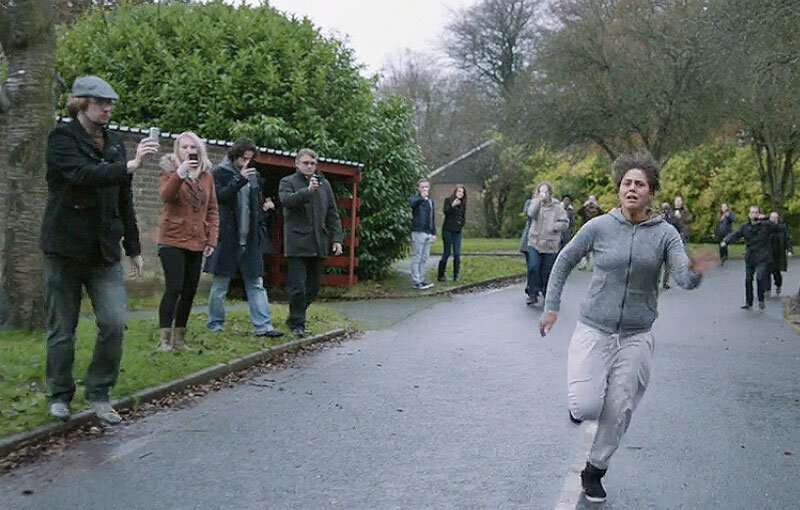By Sarah Danielzadeh
In the Netflix science fiction anthology series “Black Mirror,” an episode called “White Bear” displays a terrifyingly dystopian world in which media technology has compelled people to become psychotic killers or silent voyeurs, unwilling to intervene or provide assistance to a fellow citizen in need. Central to the plot is an interracial couple involved in a murder.
Wendy Sung, a professor of Critical Media Studies at UT Dallas and an alumna of the UC President’s Postdoctoral Fellowship program, joined UCSB Film and Media Studies for a colloquium to analyze the “White Bear” episode in the context of racial, anti-Black violence in the United States.
Wendy Sung, professor of Critical Media Studies at UT Dallas and alumna of the UC President’s Postdoctoral Fellowship program
“This episode reinvented the prison system as an entrepreneurial, technological and culture industry,” Sung said.
In the episode, a character named Victoria is a Black working-class woman who wakes up in front of a television screen displaying a mysterious, abstract logo. She is not able to recall her own name and her memories are completely erased. She comes across a photograph of a young girl and assumes that the child is her daughter. Victoria spends an entire day begging people to help her, but they just silently record her on their mobile phones while others are chasing her down to kill her.
Towards the end of the “White Bear” episode when Victoria confronts her attackers, the scene dramatically shifts to a shocking reveal: The dystopian world of silent voyeurs is actually an elaborately staged play within an amusement park with Victoria as the main attraction. Victoria and the audience learn what the silent voyeurs and killers have known all along: that Victoria is not the mother of the young Black girl who is pictured at the beginning of the episode, but rather an accomplice to the child’s murder, having helped abduct and videotape the young girl’s death at the hands of her white fiancé.
“The spectators in the episode mirrored back a United States of spectators watching anti-Black violence.”
-Wendy Sung, UT Dallas
Victoria’s experience of racial terror is really just part of a staged performance within what is called “White Bear Justice Park,” a prison-like space designed to punish Victoria every day by subjecting her to the same psychological torture her victim experienced. The amusement park got its name from the murdered child’s stuffed animal, a plush white bear. The “killers” are actually just actors who are employed by the park and the mysterious logo is the park’s company trademark, symbolizing pain and revenge.
Sung, a media scholar, pointed out that the amusement park in the show is funded by corporate capital, so Victoria loses her right to personhood for government profit. In essence, people are paying to watch a criminal suffer and to take part in the torture by spectating.
She said that although activism on behalf of racial justice in the U.S. has persisted for decades, there is now a digital divide as millions of people have the ability to misconstrue and redefine video accounts of police brutality. The mass consumption of these videos is then used to politicize issues of racial violence and further polarize Americans.
Viewed in the context of Sandra Bland’s 2015 arrest and death in a jail cell, the episode showed the impact of recording and sharing videos of police brutality. “White Bear was haunting because audiences could so easily read it as an indictment of themselves,” Sung said. “The spectators in the episode mirrored back a United States of spectators watching anti-Black violence.”
An image from the British series Black Mirror’s “White Bear” episode, displaying Victoria running from spectators
Sung said this episode allows us as American citizens to analyze what it’s like to constantly watch racial violence on our technological devices. As the audience, we are engaging in accounts of Black trauma as participants. “We are in a world where technological seeing does not equate to justice or freedom from racial violence,” Sung said.
After George Floyd’s death in May of 2020, America witnessed its largest social movement in U.S. history. Polls suggested that about 15 million to 26 million people in the U.S. participated in demonstrations over the death of George Floyd and others. While social media postings and public support dwindled, many people still gained a new sense of awareness by witnessing the movement’s protests from their phones.
Witnessing George Floyd’s death on social media led many Americans to actively support the Black Lives Matter movement. But, others used social media to turn his brutal death into a joke. Sung brought up “The George Floyd Challenge,” in which some social media users reenacted Floyd’s scene of death to further dehumanize Black life and uphold white supremacy.
“We are in a world where technological seeing does not equate to justice or freedom from racial violence.”
-Wendy Sung, UT Dallas
Evidence of racially targeted police brutality is important for holding violent police officers accountable and for galvanizing social movements, but it goes both ways, Sung said, not always leading to progress. “We can be attendant to both the potentialities and the limits of what visual capture of racial violence does in the face of liberatory discourse surrounding new technologies.”
Sung considered the “White Bear” episode to be an innovative attempt at displaying what mass spectatorship looks like. She ended her talk by comparing Victoria’s looping memory loss and daily torture to the ways in which we repeatedly consume images of Black people being abused or murdered.
“We can’t watch George Floyd without recalling the histories of Rodney King and the accumulation of these horrific instances of racial violence. So, subjectively, we are also on that loop constantly witnessing Black suffering,” Sung said.
Sarah Danielzadeh is a fourth year English major and Professional Writing minor. She is a Web and Social Media intern for the Division of Humanities and Fine Arts.



